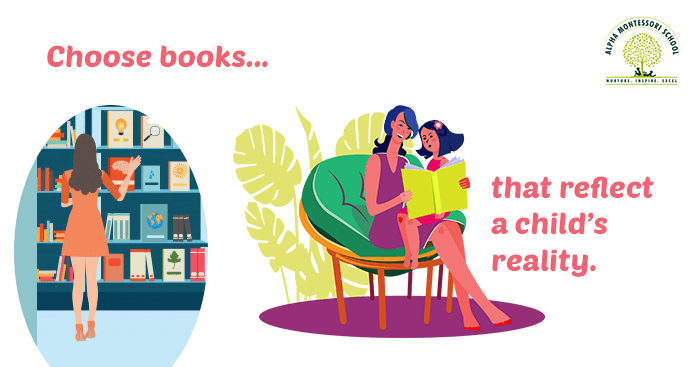Prepared environments and reading cues go a long way in raising young readers.
We all want to raise readers. Reading with your child directly impacts his or her academic proficiency. It is also an essential life skill. From books, children learn to communicate and present their ideas. They use it to understand the world. Reading inspires creativity, helps them regulate their emotions and thrive in social situations.

In this Comprehensive Guide You’ll Discover:
As parents, we use many ways to make our children fall in love with reading. We surround them with beautiful books, stock bestseller lists in our home libraries and continuously encourage them to read with us.
The Importance of Reading to Your Child
You can read books to children who are as young as 2!
A child’s experience with books begins very early. You can read books to children who are as young as 2! They may not make sense of the words but they still listen and watch eagerly as the parent reads out loud, points, turns the pages or uses the flaps if it is an interactive board book. Babies love to touch, feel, turn and handle board books. By age 4, they learn to decode and make meaning in the simplest sense. They become independent readers at the age of 6 or 7.
The statistics on reading to your child show that reading truly is a life skill with far-reaching outcomes. According to the National Education Association (NEA) in America, the more students read or are read to for fun on their own time and at home, the higher their reading scores tend to be. In fact, the National Institute for Early Education Research, which is also based in America, the earlier you start, the better. By age 3, roughly 85% of the brain is developed.
Want more interesting facts about reading to your child? A Yale University study showed that 3/4th of students who are poor readers in the 3rd grade will remain poor readers in high school and this can give them a lifelong disadvantage. The MetaMetrics’ Lexile mapping across schools in America also showed that a reading gap between expected and actual reading competency noticed in early grades at the beginning of school only grew wider. It became to close this gap over the course of 12 years of schooling. There is no doubt that the benefits of reading to your child are many. As you can see, this is a skill that has a lifelong impact.
Curious about reading milestones and how to encourage your child at every stage of their reading journey? Here’s what you can do.
- Allow your child to touch the book and turn pages. Infants and young toddlers benefit from board books that can hold up to their sometimes rough handling.
- Use visual, auditory and kinesthetic learning styles to develop reading. This brings in a mind-body connection and improves retention of information.
- Read 10 minutes a day with your child to instill a life-long love of reading.
- Pick a variety of topics to read about to keep your child interested in daily reading.
Effects of Reading on Child Development
Books contain 50% more words than other media.
Unlike television or smartphones, books contain many words that children are unlikely to encounter frequently in spoken language. In fact, they contain 50% more words than other media. While speaking to a child is great, reading gives them access to a felicity with words and a wonderful toolkit to communicate to the world .

Montessori reading describes the sensitive period for language – this is right up to 6 years of age. Children in this stage are ripe for language explorations and expressions. They are like sponges, absorbing everything they hear. The beauty of the Montessori method is that it is a child-led approach and gives children many ways to inspire themselves to read. The effects of not reading to your child are plain and simple. When they do not have access to rich language and reading experiences, they are at a clear disadvantage when it comes to children who do read regularly.
Here, we have listed 4 ways to encourage reading with your child.
- Role model the reading habit
- Create reading cues
- Read aloud to children!
- Let children choose books they like
1. Role model the reading habit
When my son was a toddler, the minute my son sees me picking up a book, he would pick one too! Children are constantly looking to us for inspiration. They are role modeling their behavior on parents and teachers. Make time to read every day and read with them too!
2. Create reading cues
In Montessori, the environment is designed to help children to want to discover the world through reading. You can create a similar environment at home and also set reading cues during the day. The bedtime reading ritual is a wonderful cue and it also doubles as a cue to wind down and sleep.
You can also create little reading nooks where your child can go to explore books. Find other interesting reading cues to take with you on the go. I always read when I am waiting in the airport and one of us always reads out loud when we are traveling. You can even create time slots when you and your child can read your respective books.
3. Read aloud to children!
Reading out loud is a great way to hook a reluctant reader. When you read books out loud to your children, they acquire early language skills and develop sound awareness. They also build key listening skills.

Most importantly, this is such a wonderful way to bond with your children and to really form important connections through reading. Such experiences remain with them throughout their lives.
4. Let children choose books they like
Take your child with you to bookshops and libraries. A library is an incredible way to get your child to love and treasure books. Libraries are reading spaces and cues in themselves.
You must also have noticed that your child wants to read the same books over and over again. My son was obsessed with Eric Carle’s, The Very Hungry Caterpillar for many months and would demand that I read it a minimum of five times a day! I would oblige him of course. There are so many reasons why they crave this repetition. It is comforting and familiar but on a deeper level, they are connecting to the book’s rhythm and its sound patterns. They are also diving into the book and making meaning out of it. Every reading seems different, new and special!
Reading Strategies according to the Child’s Age
Infants: If you are an expectant mother, read to your baby in utero. With infants, encourage them to touch the book and turn the pages. Mimic sounds when looking in a mirror. Use nomenclature cards that match objects to the card and also to name feelings and expressions. Use baby sign language.
Toddlers: Use objects and puppet shows to emphasize phonics. Use tracing sandpaper letters with the child’s fingers and say the sounds out loud.
Primary: Match sounds of objects to letters. Work with books that encourage sound blending. Use phonics books with short vowel words. Encourage your child to follow the words with their finger while being read to.
Elementary: Work on diagraphs, long vowels, and vowel blends through tangible objects to achieve muscle memory. Encourage the child to work on book reports. Work on their reading comprehension and target reading fluency by bringing in books with more complex words and long vowels.
Montessori uses clever ways to raise readers
In Montessori, we have some interesting ways to raise lifelong readers. A few strategies really work in building an independent reading habit. We design and optimize a learning environment in such a way that it lights a spark in the child to learn independently. This environment is also designed to give children freedom. At the same time, they develop a certain work ethic, which is a great life skill.

The Montessori method encourages children to visualize everything they learn and to use all their senses. Montessori reading materials are visual and multisensorial. This really ties in beautifully with reading, which is not just about parsing those words. They learn to make real-life connections through their senses and to picture scenes or scenarios in their heads. By taking a Montessori approach and joining visual, auditory and kinesthetic learning styles, reading is developed with a mind-body connection which improves retention of information.
How to choose books, the Montessori way?
Choose books that reflect a child’s reality. Children love books about home, family, pets, and school because they can make exciting connections and understand their reality. Real-world books about places, animals, plants, and nature are treasure troves for children because there is always something new to discover when reading them again. Children also love nature and feel a deep sense of connection with it.

When he was four, my son loved a book about insects and we have that book on our shelves to this very day! This is not a book that uses baby talk but has long sentences and many facts about insects. We would read and explain them to our son. I read somewhere that we should buy books that read up to our children and not down to them. While we did have our share of the baby books with simple little sentences, we also read longer sentences to him and he learned many new words and expressions.
Make reading a joyful and shared family experience. As the Montessori experience segues into adolescence, the spirit of reading, learning and exploring together becomes vital. When reading is a family affair, it produces lifelong readers.
Must-Read Montessori Books for Parents and Children
Having said that, We have listed Top 10 Must-Have Montessori Books for Children according to the age groups that focus on the reality and learning they need and Top 10 Must-Read Montessori Books for Parents to raise your Toddler in Montessori way.
Download them here:
Top 10 Must-Have Montessori Books for Children
Top 10 Must-Read Montessori Books for Parents
Do you have ideas or suggestions to add to this list of Developing Good Reading Habits in Children, the Montessori way? Let us know in the comments below.

 March 10th, 2020
March 10th, 2020
